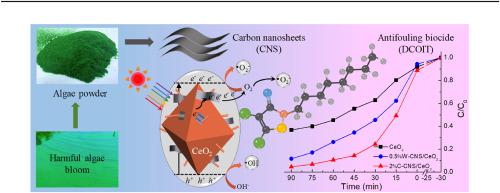当前位置:
X-MOL 学术
›
J. Environ. Manag.
›
论文详情
Our official English website, www.x-mol.net, welcomes your
feedback! (Note: you will need to create a separate account there.)
Coupling harmful algae derived nitrogen and sulfur co-doped carbon nanosheets with CeO2 to enhance the photocatalytic degradation of isothiazolinone biocide
Journal of Environmental Management ( IF 8.0 ) Pub Date : 2024-03-22 , DOI: 10.1016/j.jenvman.2024.120621 Chenyan Hu 1 , Qingdi Chen 1 , Suxin Wu 1 , Jiali Wang 1 , Shizhen Zhang 2 , Lianguo Chen 3
Journal of Environmental Management ( IF 8.0 ) Pub Date : 2024-03-22 , DOI: 10.1016/j.jenvman.2024.120621 Chenyan Hu 1 , Qingdi Chen 1 , Suxin Wu 1 , Jiali Wang 1 , Shizhen Zhang 2 , Lianguo Chen 3
Affiliation

|
Removing the algae from water bodies is an effective treatment toward the worldwide frequently occurred harmful algae blooms (HAB), but processing the salvaged algae waste without secondary pollution places another burden on the economy and environment. Herein, a green hydrothermal process without any chemical addition was developed to resource the HAB algae ( sp.) into autogenous nitrogen and sulfur co-doped carbon nanosheet materials C–CNS and W–CNS, whose alga precursors were collected from pure culture and a wild bloom pond, respectively. After coupling with CeO, the obtained optimal C–CNS/CeO and W–CNS/CeO composites photocatalytically degraded 95.4% and 88.2% of the marine pollutant 4,5-Dichloro-2-n-octyl-4-isothiazolin-3-one (DCOIT) in 90 min, significantly higher than that of pure CeO (63.15%). DCOIT degradation on CNS/CeO was further conducted under different conditions, including pH value, coexisting cations and anions, and artificial seawater. Although different influences were observed, the removal efficiencies were all above 76%. Along with the ascertained good stability and reusability in five consecutive runs, the great potential of CNS/CeO for practical application was validated. UV–vis DRS showed the increased light absorption of CNS/CeO in comparison to pure CeO. PL spectra and photoelectrochemical measurements suggested the lowered charge transfer resistance and thereby inhibited charge recombination of CNS/CeO. Meanwhile, trapping experiments and electron paramagnetic resonance (EPR) detection verified the primary roles of hydroxyl radical (OH) and superoxide radical (O) in DCOIT degradation, as well as their notably augmented generation by CNS. Consequently, a mechanism of CNS enhanced photocatalytic degradation of DCOIT was proposed. The intermediates involved in the reaction were identified by LC-QTOF-MS, giving rise to a deduced degradation pathway for DCOIT. This study offers a new approach for resourceful utilization of the notorious HAB algae waste. Besides that, photocatalytic degradation has been explored as an effective measure to remove DCOIT from the ocean.
中文翻译:

有害藻类氮硫共掺杂碳纳米片与CeO2耦合增强异噻唑啉酮杀菌剂的光催化降解
对水体中经常发生的有害藻华(HAB)进行去除是一种有效的处理方法,但对打捞上来的藻类废物进行处理而不造成二次污染又给经济和环境带来了负担。本文开发了一种不添加任何化学物质的绿色水热工艺,将 HAB 藻类资源化为自生氮硫共掺杂碳纳米片材料 C-CNS 和 W-CNS,其藻类前体是从纯培养物中收集的,并通过分别是野花池塘。与CeO偶联后,获得的最佳C-CNS/CeO和W-CNS/CeO复合材料光催化降解了95.4%和88.2%的海洋污染物4,5-二氯-2-正辛基-4-异噻唑啉-3-酮(DCOIT)在90分钟内显着高于纯CeO (63.15%)。在不同的条件下,包括pH值、共存的阳离子和阴离子以及人工海水,进一步进行了DCOIT对CNS/CeO的降解。尽管观察到的影响不同,但去除效率均在76%以上。随着连续五次运行确定的良好稳定性和可重复使用性,CNS/CeO在实际应用中的巨大潜力得到了验证。紫外可见 DRS 显示,与纯 CeO 相比,CNS/CeO 的光吸收增加。 PL光谱和光电化学测量表明电荷转移电阻降低,从而抑制CNS/CeO的电荷复合。同时,捕获实验和电子顺磁共振(EPR)检测证实了羟基自由基(OH)和超氧自由基(O)在DCOIT降解中的主要作用,以及CNS显着增强了它们的生成。因此,提出了中枢神经系统增强DCOIT光催化降解的机制。 通过 LC-QTOF-MS 鉴定了反应中涉及的中间体,从而推导出 DCOIT 的降解途径。这项研究为臭名昭著的 HAB 藻类废物的资源化利用提供了一种新方法。除此之外,光催化降解已被探索作为从海洋中去除 DCOIT 的有效措施。
更新日期:2024-03-22
中文翻译:

有害藻类氮硫共掺杂碳纳米片与CeO2耦合增强异噻唑啉酮杀菌剂的光催化降解
对水体中经常发生的有害藻华(HAB)进行去除是一种有效的处理方法,但对打捞上来的藻类废物进行处理而不造成二次污染又给经济和环境带来了负担。本文开发了一种不添加任何化学物质的绿色水热工艺,将 HAB 藻类资源化为自生氮硫共掺杂碳纳米片材料 C-CNS 和 W-CNS,其藻类前体是从纯培养物中收集的,并通过分别是野花池塘。与CeO偶联后,获得的最佳C-CNS/CeO和W-CNS/CeO复合材料光催化降解了95.4%和88.2%的海洋污染物4,5-二氯-2-正辛基-4-异噻唑啉-3-酮(DCOIT)在90分钟内显着高于纯CeO (63.15%)。在不同的条件下,包括pH值、共存的阳离子和阴离子以及人工海水,进一步进行了DCOIT对CNS/CeO的降解。尽管观察到的影响不同,但去除效率均在76%以上。随着连续五次运行确定的良好稳定性和可重复使用性,CNS/CeO在实际应用中的巨大潜力得到了验证。紫外可见 DRS 显示,与纯 CeO 相比,CNS/CeO 的光吸收增加。 PL光谱和光电化学测量表明电荷转移电阻降低,从而抑制CNS/CeO的电荷复合。同时,捕获实验和电子顺磁共振(EPR)检测证实了羟基自由基(OH)和超氧自由基(O)在DCOIT降解中的主要作用,以及CNS显着增强了它们的生成。因此,提出了中枢神经系统增强DCOIT光催化降解的机制。 通过 LC-QTOF-MS 鉴定了反应中涉及的中间体,从而推导出 DCOIT 的降解途径。这项研究为臭名昭著的 HAB 藻类废物的资源化利用提供了一种新方法。除此之外,光催化降解已被探索作为从海洋中去除 DCOIT 的有效措施。




















































 京公网安备 11010802027423号
京公网安备 11010802027423号